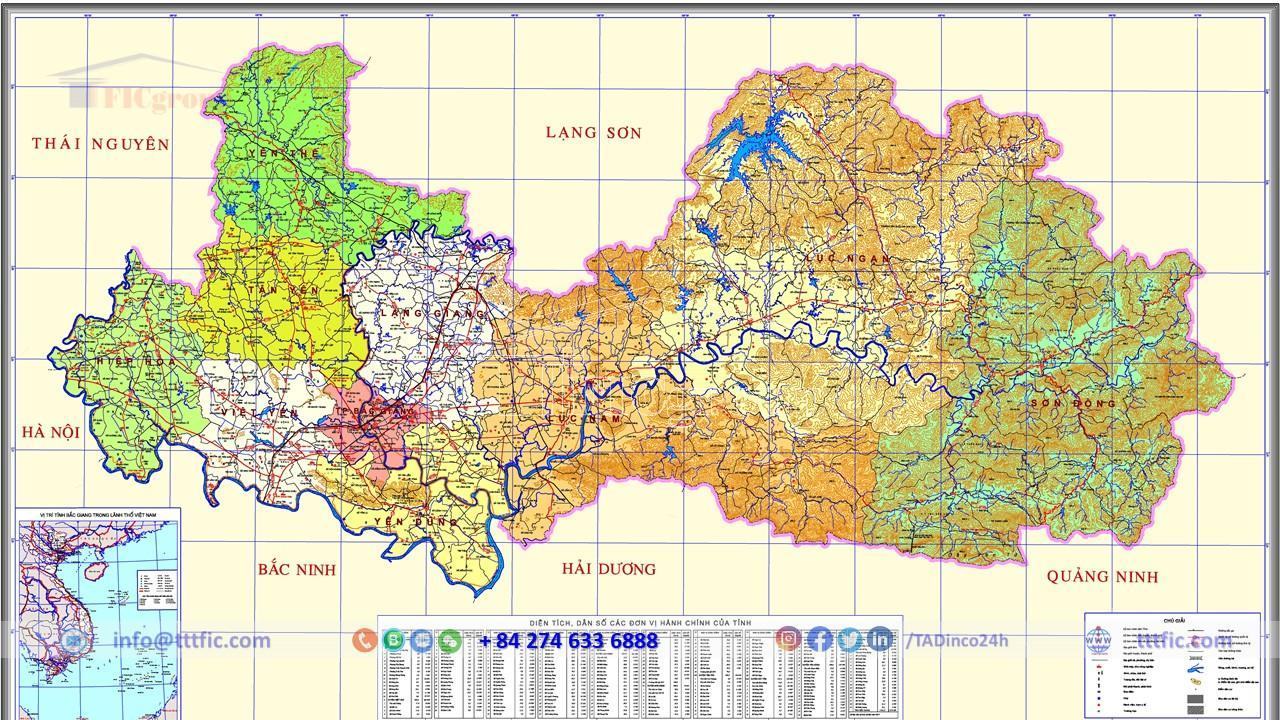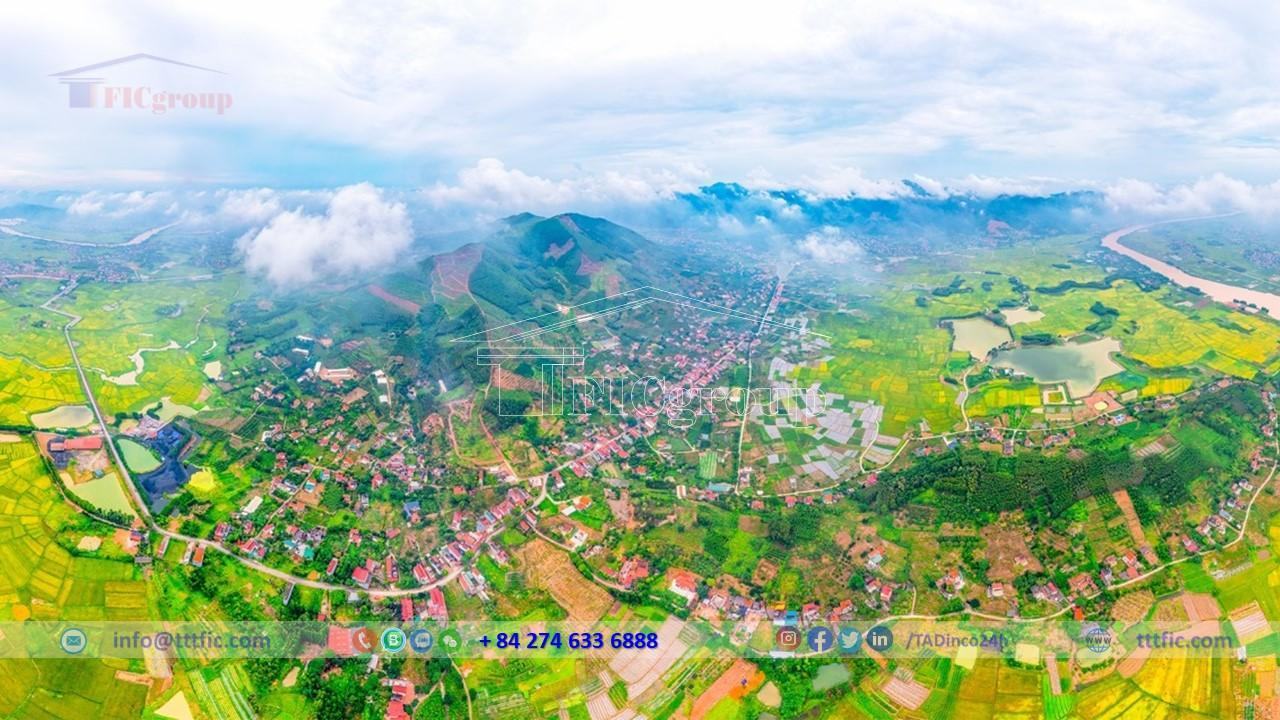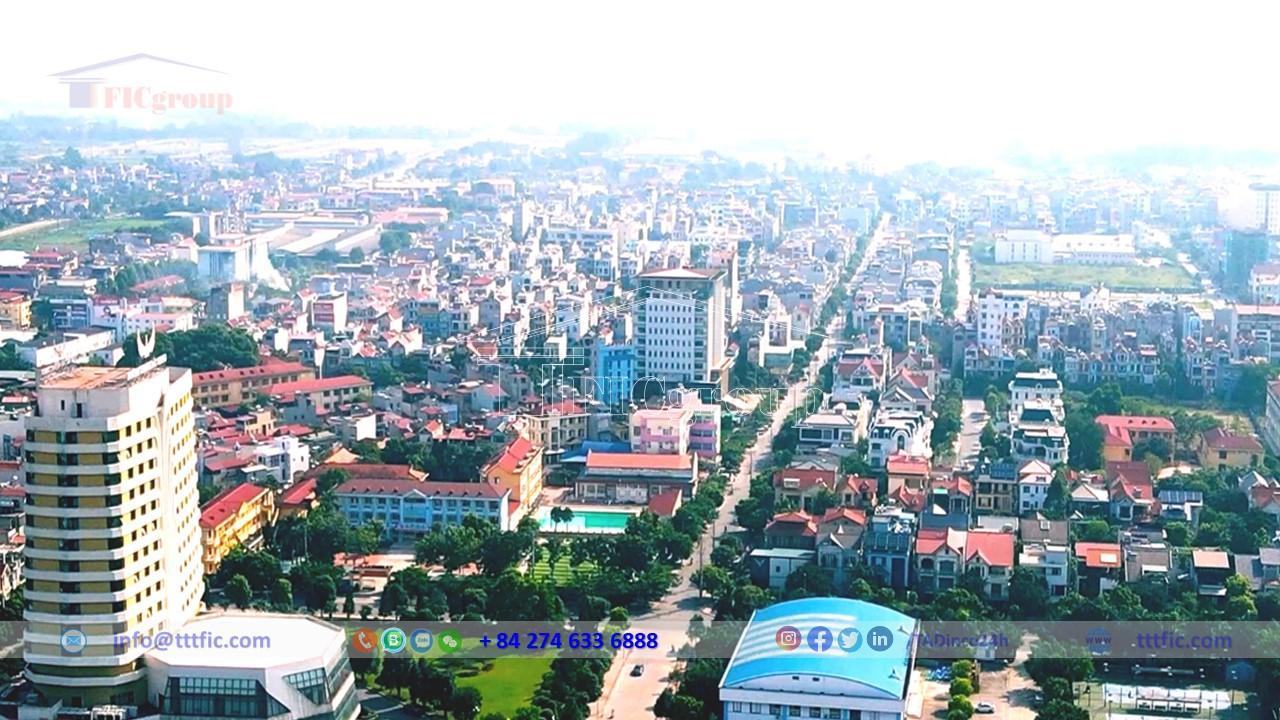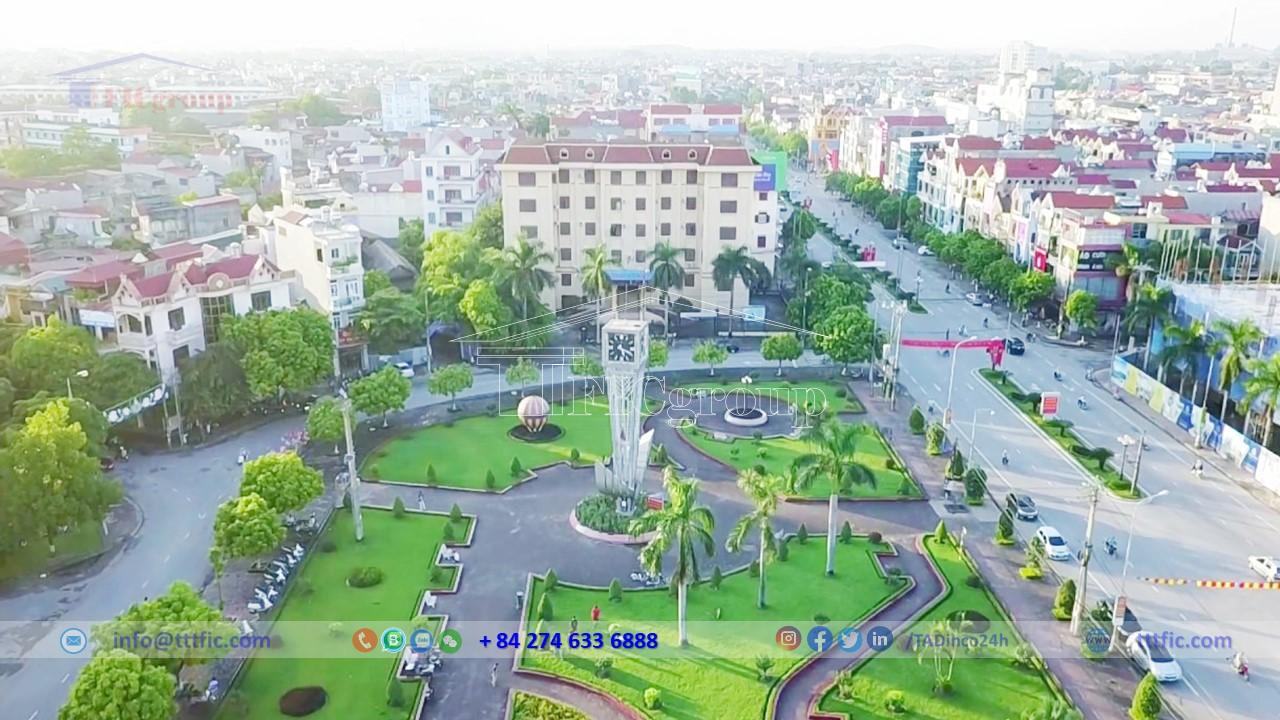Overview of Bac Giang Province:
Bac Giang province, a province located in the Northeast region of Vietnam, is known for its rich cultural heritage and being part of the Hanoi metropolitan area. It occupies a significant portion of the former Kinh Bac region, characterized by its vibrant cultural traditions, particularly the Quan ho folk songs, with 23 ancient Quan ho villages recognized by UNESCO. The provincial capital is Bac Giang City, situated 50 km away from the central Hanoi.
In 2022, the estimated population of Bac Giang reached 1.891 million people, making it the most populous province in the Central and Northern Mountainous region. It also boasts a leading position in terms of economic scale. Bac Giang ranks 11th in population among Vietnamese administrative units and 13th out of 63 provinces in terms of Gross Regional Domestic Product (GRDP) in 2022, with an estimated value of nearly 155,900 billion Vietnamese Dong (equivalent to an average GRDP per capita of $3,400 USD). In the same year, Bac Giang achieved an impressive GRDP growth rate of 19.3%, securing the second spot nationwide.
Geography of Bac Giang Province:
Geographical location:
Bac Giang is a province located in the Northeast region of the North Central Coast in Vietnam. It has the following geographical positions:
- To the east, it borders Quang Ninh province.
- To the north, it borders Lang Son province.
- To the west, it borders Thai Nguyen province and the capital city of Hanoi.
- To the south, it borders Bac Ninh province and Hai Duong province.
The extreme points of Bac Giang province are as follows:
- The northernmost point is located in the Goc Bong mountainous area, Dong Tien commune, Yen The district.
- The easternmost point is located in the Khe Ro Nature Reserve, An Lac commune, Son Dong district.
- The southernmost point is located in Nam Son hamlet, Dong Phuc commune, Yen Dung district.
- The westernmost point is located in Da Hoi hamlet, Hop Thinh commune, Hiep Hoa district.

Geographical features:
Bac Giang province encompasses an area of 3,825.75 square kilometers, equivalent to 1.2% of Vietnam’s total natural area. Agricultural land occupies 32.4%, while forestry land with forests accounts for 28.9%. The remaining land comprises unused hills, mountains, rivers, and other types.
With diverse topography, Bac Giang acts as a transition zone between the northern mountains and the Red River Delta. Although hills and mountains dominate the province, the terrain remains relatively connected. The northern and southeastern areas feature high mountainous forests, ranging from 300 to 900 meters in altitude. Nestled between two curved mountain ranges, Dong Trieu Arch to the southeast and Bac Son Arch to the northwest, lie the low hills and midland plains. The Yen Tu mountain range within Dong Trieu Arch reaches heights of 300-900 meters, with the highest peak standing at 1,068 meters. Notably, the province’s northeastern mountainous region, bordering Quang Ninh, hosts the Khe Ro primeval forest, covering 7,153 hectares. This forest boasts a diverse array of fauna and flora, including 236 species of timber trees, 255 medicinal plant species, 37 mammal species, 73 bird species, and 18 reptile species.
Hydrology:
Bac Giang province boasts an extensive network of rivers and streams, spanning 374 kilometers. Among them, the prominent ones are Luc Nam River, Thuong River, and Cau River. Luc Nam River flows through limestone mountains, ensuring its crystal-clear water year-round. Meanwhile, Thuong River originates from distinct regions, resulting in dual streams: one clear and one turbid.
Apart from the waterways, Bac Giang is adorned with enchanting lakes and ponds, including Cam Son Lake and Khuon Than Lake. Cam Son Lake, situated near the border of Lang Son province, stretches 30 kilometers in length, with a maximum width of 7 kilometers and a narrowest point of 200 meters. With a water surface area of 2,600 hectares, expanding to 3,000 hectares during the rainy season, Cam Son Lake offers a breathtaking expanse. On the other hand, Khuon Than Lake covers a water surface area of 240 hectares, featuring five hills covered in lush 20-year-old pine forests. Visitors can navigate Khuon Than Lake using pedal boats or motorized boats while relishing the performances by local ethnic groups like the San Chi, Cao Lan, and Nung, who showcase their traditional songs. Additionally, they can indulge in the region’s unique products such as hazelnuts, honey, and tắc kè wine.

Economy of Bac Giang Province:
Bac Giang province’s GRDP in 2022 reached 103,409.6 trillion VND, a 19.3% increase from the previous year. Industrial and construction sectors grew by 26.65%, surpassing 2021’s 10.03% growth. The service sector saw a 7.49% growth, and agriculture, forestry, and fisheries grew by 1.97%. All sectors showed significant growth.
The province’s total GRDP in 2022 was estimated at 155,876 trillion VND. The economic structure continued to shift positively, with agriculture, forestry, and fisheries at 14.9%, industrial and construction at 62.3%, services at 20.7%, and taxes on products minus subsidies at 2.1%.
The industrial and construction sector quickly recovered, contributing to overall growth. Its value added reached 71,924 trillion VND, growing by 26.65%. The service sector rebounded due to strict disease control and high vaccination rates, resulting in increased consumer sentiment and purchasing power. The value added in services reached 17,031.7 trillion VND. Wholesale and retail, repair of vehicles, transportation and warehousing, and accommodation and food services grew significantly. The market remained stable, and innovative trade promotion activities were emphasized.
The agricultural, forestry, and fisheries sector overcame difficulties and achieved outstanding results. Its value added reached 12,282.2 trillion VND, growing by 1.97%. These results reaffirmed its crucial role as the backbone of the economy.
Agriculture, forestry, aquaculture:
Agriculture:
In 2022, agriculture in Bac Giang province experienced favorable weather conditions, resulting in the continued growth of major crops.
Collaboration and value chain integration contributed to the large-scale production and development of crops.
Effective disease control measures and proactive irrigation management ensured minimal pest and disease issues.
As a result, crop yields and production increased compared to the previous year.
The total annual crop cultivation area was nearly 154.4 thousand hectares, accounting for 98.1% of the previous year’s performance.
The reduction in annual crop area was mainly due to crop conversion and land allocation for infrastructure expansion.
Specifically, the rice cultivation area for the whole year was over 97.7 thousand hectares, representing 98% of the corresponding period.
The corn cultivation area in the province reached over 10 thousand hectares, equivalent to 99.5% of the corresponding period.
In animal husbandry, effective disease control measures and the adoption of modern production models ensured food safety and increased VietGAP implementation.
The pig population in the province recovered rapidly, reaching 918,785, equivalent to 100.9% of the corresponding period in 2021.
The buffalo population was estimated at 31,100, accounting for 88.8% of the corresponding period.
Poultry farming remained stable and showed significant growth, with an estimated population of 20,102 thousand, representing 100.9% of the corresponding period in 2021.
Forestry:
The forestry production in 2022 progressed favorably, with a focus on tree planting, care, and forest protection.
There was significant attention given to achieving the targets for forest planting and development, which were on par with the planned objectives.
The quality and structure of planted forests underwent a significant transformation, shifting from protective forests to productive forests and ecological conservation.
This approach aimed to combat erosion, sedimentation, land degradation, and gradually enrich the soil, while creating employment opportunities for local residents.
Specifically, the concentrated new planting area reached approximately 9,450 hectares, equivalent to 101% of the corresponding period.
The number of dispersed planted trees reached 50.25 thousand, representing 102.8% of the corresponding period.
The estimated timber production from logging exceeded 805.4 thousand cubic meters, accounting for 100.5% of the previous year’s performance.
The relevant authorities continued to enhance forest protection measures, fire prevention, and firefighting efforts.
There were only three forest fire incidents, which reduced by eight compared to the previous year.
Aquaculture:
In 2022, aquaculture activities faced various weather fluctuations, including late winter and deep frost, but still experienced favorable conditions.
Despite the challenges, the sufficient rainfall ensured water supply for localities, promoting aquaculture operations within the province.
Overall, the total annual aquaculture production reached 52,798 tons, indicating a 5.1% increase compared to the previous year.
Specifically, the year-round aquaculture output reached 49,603 tons, reflecting a 5.8% increase, while the annual harvest output reached 3,195 tons, experiencing a 4.3% decrease compared to the corresponding period.
Industry:
Bac Giang province, situated on the economic corridor from Nam Ninh to Hanoi and Hai Phong, has advantageous location for economic development and cultural exchange in the region.
The province has developed 6 industrial parks covering 1,462 hectares and 38 industrial clusters spanning over 1,208 hectares. Additionally, 3 new industrial parks have been approved and expansions are underway.
These industrial zones are concentrated in districts like Viet Yen, Yen Dung, and Hiep Hoa, strategically located along National Highway 1A, with easy access to major urban centers and various transportation routes.
Bac Giang is approximately 40-50 km from Hanoi, with Noi Bai International Airport at 50 km, Hai Phong Port at 110 km, and Huu Nghi Quan Border Gate at 120 km.
The province boasts existing industrial parks, such as Dinh Tram, Song Khe – Noi Hoang, Quang Chau, Van Trung, Hoa Phu, and Viet Han. It is also developing new industrial parks, including Yen Lu, Yen Son-Bac Lung, and Tan Hung.
Bac Giang plans to establish additional industrial zones and clusters in Yen Dung, Viet Yen, Hiep Hoa, and Lang Giang districts, with the goal of having 27 industrial parks and 69 industrial clusters by 2030.
Efforts are being made to improve the investment and business environment, enhance infrastructure, train and improve the quality of human resources, and streamline administrative procedures.
As of January 2021, Bac Giang has attracted a significant number of domestic and foreign investment projects, solidifying its position as a major industrial center in the northern region and the country as a whole.
Trade, services and price index:
The Service sector faced significant impacts from the Covid-19 pandemic in 2021 but experienced a strong recovery in 2022. Market management and commercial activities received close attention and guidance from state authorities, ensuring stable supply and preventing price fluctuations.
Normal operations resumed for businesses affected by the pandemic, resulting in increased income for workers and higher purchasing power. In December, the total retail sales of goods reached approximately 3,260 billion VND, a 20.92% increase compared to the same period, contributing to a total retail sales estimate of 36,300 billion VND in 2022, a 20.47% increase year-on-year.
Several product categories showed significant growth, such as the Wood and Construction Materials group, reaching an estimated 7,365 billion VND, a 28.38% increase. The Cultural and Educational Supplies group achieved approximately 366 billion VND, a 24.58% increase. The Food and Beverage group reached an estimated 9,858 billion VND, an 8.56% increase. Furthermore, revenue from various types of fuel saw a substantial increase, reaching an estimated 6,208 billion VND, a 66.08% rise compared to the same period.

Residential:
According to the population survey conducted as of April 1, 2019, Bac Giang province had a population of 1,803,950 people, with a population density of 463 people per square kilometer, 1.5 times the national average. The urbanization rate as of 2022 was 23.9%.
Bac Giang province is the 12th most populous province in the country and the most populous in the North Central and Northern Mountainous regions, with a population of 1.8 million.
The province is home to six ethnic groups, with the majority being the Kinh people, accounting for 88.1% of the total population. The Nung people make up 4.5%, followed by the Tay people at 2.6%. The San Chay and San Diu ethnic groups each account for 1.6% of the population, while the Chinese population is 1.2% and the Dao people are 0.5%. The male population represents approximately 49.95% of the total population, and the female population is around 50.05%. The working-age population makes up about 62.15% of the total population, with 28% having vocational training. The proportion of impoverished households is 7.2%.
As of April 1, 2019, the province had a total of 8 different religions, with 38,913 followers. The largest religious group is Catholicism with 36,269 followers, followed by Buddhism with 2,607 followers. Other religions include Protestantism with 16 followers, Islam with 10 followers, Hoa Hao Buddhism with 5 followers, Caodaism with 3 followers, Minh Ly Daoism with 2 followers, and 1 follower of Buu Son Ky Huong.










